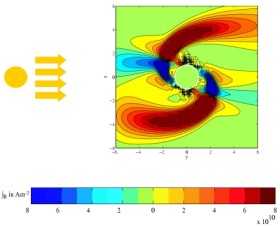
|
Science Highlight January 2006
|
 |

|
Science Highlight January 2006
|
 |
Since their discovery starting 1995 we know about more than 100 extrasolar planets. The actual number can be found in the ![]() Internet-Encyclopeadia of Extrasolar Planets of J. Schneider.
Observations of these systems are so difficult that only a few details are known. Many of the planetary systems are very different to our
Internet-Encyclopeadia of Extrasolar Planets of J. Schneider.
Observations of these systems are so difficult that only a few details are known. Many of the planetary systems are very different to our ![]() Solar System. We find e.g. gaseous giant planets very close to their stars. Mercury, the innermost planet of the Solar System, has a semi-major axis of about 0.387 AU, which is about 17 times larger than the semi-major axis of OGLE-TR-56 b (the closest of the today's known planets). In stellar radii, OGLE-TR-56 b is only 4.4 stellar radii away from its "Sun". In our Solar System we can find such small distances only between planets and their moons, e.g. between Jupiter and it's moon Io. Io has a distance of about 5.7 Jovian radii. A strong electromagnetic interaction takes place between Io and Jupiter. With this in mind we asked ourselves: Do these extrasolar planetary systems with planets at such extremely small orbital distances act like Io and Jupiter? As we cannot fly there and as there are no appropriate observations so far a PHD thesis, defended in December 2005, investigated this question by means of numerical simulations.
Solar System. We find e.g. gaseous giant planets very close to their stars. Mercury, the innermost planet of the Solar System, has a semi-major axis of about 0.387 AU, which is about 17 times larger than the semi-major axis of OGLE-TR-56 b (the closest of the today's known planets). In stellar radii, OGLE-TR-56 b is only 4.4 stellar radii away from its "Sun". In our Solar System we can find such small distances only between planets and their moons, e.g. between Jupiter and it's moon Io. Io has a distance of about 5.7 Jovian radii. A strong electromagnetic interaction takes place between Io and Jupiter. With this in mind we asked ourselves: Do these extrasolar planetary systems with planets at such extremely small orbital distances act like Io and Jupiter? As we cannot fly there and as there are no appropriate observations so far a PHD thesis, defended in December 2005, investigated this question by means of numerical simulations.
 Figure 1 illustrates our findings:
The yellow circle to the left of the figure is the star. The white circle in the figure presents a planet of Jupiter size. The distance between both is 0.0225 AU. What you see is a cut perpendicular to the ecliptic of the system. We simulated the interaction of an assumed planetary magnetic field with the stellar wind. It's flow direction is indicated with the yellow arrows.
Figure 1 illustrates our findings:
The yellow circle to the left of the figure is the star. The white circle in the figure presents a planet of Jupiter size. The distance between both is 0.0225 AU. What you see is a cut perpendicular to the ecliptic of the system. We simulated the interaction of an assumed planetary magnetic field with the stellar wind. It's flow direction is indicated with the yellow arrows.
Due to the interaction currents start to flow. The color now indicates the current which is aligned to the magnetic field. The upper part of the current system seems to be carried by the stellar wind into the interplanetary space, i.e. to the right. But, strikingly, the lower part seems to be connected with the star. This only happens if the planet is close enough to the star so that the stellar wind shows special properties. This is why we do not find this for the planets in the Solar System. However, a more detailed look into the Solar System reveals a similar behavior of Io and Jupiter: Both are connected with a current system, but in this case both parts of the current system are involved. This leads e.g. to strong radiation events which we can observe as bright footpoints in the Jovian aurora or as radio emissions.
But to what extent do the similarities between Io and Jupiter and a close-in extrasolar planet and it's star, respectively, hold? Is it e.g. responsible for the enhance chromospheric acitivity on HD 179949, a star with a planet, which was observed by ![]() Shkolnik et al. (2003)? This is subject of our future research. If the interaction is really strong, can it lead to superflares as
Shkolnik et al. (2003)? This is subject of our future research. If the interaction is really strong, can it lead to superflares as ![]() Rubenstein and Schaefer (2000) postulate? We do not know the answer yet but we know that we do not have to worry for possible consequences for the life on Earth:
Rubenstein and Schaefer (2000) postulate? We do not know the answer yet but we know that we do not have to worry for possible consequences for the life on Earth:
We are sufficiently far away from the Sun for something like this to happen.
| © 2009, Max Planck Institute for Solar System Research, Lindau |
Sabine Preusse, Jörg Büchner 31-01-2006 |